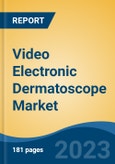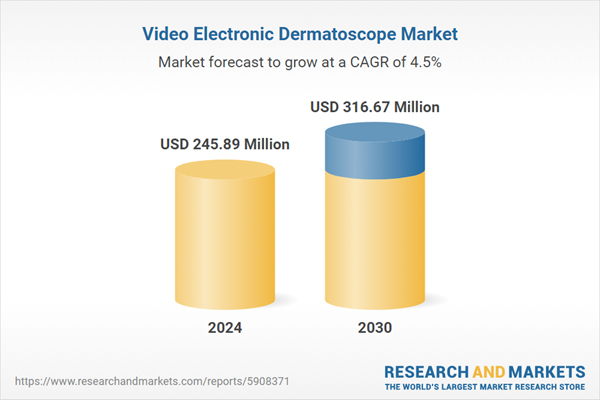Speak directly to the analyst to clarify any post sales queries you may have.
10% Free customizationThis report comes with 10% free customization, enabling you to add data that meets your specific business needs.
This device plays a crucial role in the field of dermatology, allowing healthcare professionals to accurately diagnose and monitor various skin disorders. At its core, a Video Electronic Dermatoscope consists of a high-resolution camera coupled with specialized optics and lighting systems. These components work together to capture magnified images of the skin, providing a level of detail not achievable through the naked eye alone. The resulting images are displayed on a monitor in real-time, allowing for immediate analysis and discussion with the patient.
Key Market Drivers
Growing Prevalence Of Skin Disorders
The increasing prevalence of skin disorders has been a significant driver in bolstering the Video Electronic Dermatoscope market. Skin disorders encompass a wide range of conditions, including dermatitis, psoriasis, acne, eczema, and potentially malignant lesions, among others. This surge in prevalence has led to an amplified demand for accurate and efficient diagnostic tools, propelling the adoption of Video Electronic Dermatoscopes in dermatological practices worldwide. For instance, a 2024 article reports that skin diseases impact over 3 billion people globally, presenting significant public health challenges. This widespread burden affects populations across both high-income and low- to middle-income countries, underscoring the need for improved dermatological care and preventive measures worldwide.First and foremost, the rise in skin disorders can be attributed to a myriad of factors. Changing lifestyles, increased environmental pollution, exposure to harmful ultraviolet (UV) radiation, and shifting dietary habits have contributed to a higher incidence of skin-related issues. An aging population, who are more susceptible to various dermatological conditions, further augments the prevalence rate. As individuals age, their skin undergoes natural changes, which can lead to a higher likelihood of skin disorders and the need for more thorough and frequent examinations.
Key Market Challenges
Shortage Of Skilled Professionals
The Video Electronic Dermatoscope market is facing a notable challenge in the form of a shortage of skilled professionals. This scarcity of adequately trained healthcare providers proficient in utilizing these advanced dermatological instruments is hampering the widespread adoption and optimal utilization of Video Electronic Dermatoscope. One of the primary issues arising from the lack of skilled professionals is the potential for misdiagnosis or suboptimal assessments. Video Electronic Dermatoscope are intricate devices that require a certain level of expertise to operate effectively.Without proper training, healthcare providers may struggle to capture high-quality images, adjust lighting and magnification appropriately, and interpret the visual data accurately. This could lead to misinterpretations of skin conditions, potentially resulting in incorrect diagnoses and subpar patient care. The absence of skilled professionals proficient in Video Electronic Dermatoscopy restricts the technology's potential reach, particularly in underserved or remote areas. Patients in these regions may have limited access to dermatological specialists, making it imperative for general practitioners or healthcare workers in these areas to be adequately trained in using Video Electronic Dermatoscope.
Without this training, patients in such regions may face delays in receiving accurate diagnoses and appropriate treatment. The lack of skilled professionals proficient in Video Electronic Dermatoscopy may hinder the seamless integration of this technology with electronic health record (EHR) systems. Healthcare providers need to be proficient in not only capturing and interpreting images but also in efficiently documenting and managing this digital data within the EHR platform. Without proper training, this process may be less streamlined, potentially leading to inefficiencies in patient care and record-keeping.
Key Market Trends
Integration Of Artificial Intelligence (AI) And Machine Learning Algorithms
The integration of artificial intelligence (AI) and machine learning algorithms is playing a transformative role in bolstering the market for various industries, including healthcare and dermatology. In the realm of dermatoscopy, this trend is revolutionizing the way skin conditions are diagnosed and managed. AI-powered dermatoscopic tools have demonstrated exceptional capabilities in analyzing skin lesions with a level of precision and speed that surpasses traditional methods. These algorithms have been trained on vast datasets of dermatological images, allowing them to recognize patterns and anomalies that might be imperceptible to the human eye. As a result, dermatologists are now equipped with an invaluable tool that provides them with real-time, data-driven insights, enhancing their diagnostic accuracy and confidence.The integration of AI and machine learning in dermatoscopy is not limited to diagnosis alone. These algorithms can also aid in risk assessment, providing valuable information about the likelihood of malignancy or other significant characteristics of skin lesions. By leveraging this technology, healthcare providers can make more informed decisions about treatment plans, including whether a biopsy or further intervention is necessary. This not only streamlines the diagnostic process but also ensures that patients receive timely and appropriate care. The continuous learning capabilities of AI-powered dermatoscopy systems mean that they improve over time.
As more data is collected and analyzed, the algorithms become increasingly sophisticated, refining their ability to recognize a wide range of skin conditions. This adaptability is invaluable in a field where early and accurate diagnosis can significantly impact patient outcomes. The integration of AI in dermatoscopy aligns with the broader trend of personalized medicine. By harnessing the power of AI, dermatologists can tailor treatment plans to the specific needs of each patient, taking into account their unique skin characteristics and medical history. This level of customization leads to more effective and targeted interventions, ultimately improving patient satisfaction and outcomes.
Key Market Players
- Caliber Imaging & Diagnostics
- Dynamify GmbH
- DermoScan GmbH
- Firefly Global
- FotoFinder Systems, Inc.
- HEINE Optotechnik GmbH & Co. KG
- Adamo srl.
- NIDEK CO., LTD.
- Optomed Plc.
- Quantificare SA
Report Scope:
In this report, the Global Video Electronic Dermatoscope Market has been segmented into the following categories, in addition to the industry trends which have also been detailed below:Video Electronic Dermatoscope Market, By Type:
- Traditional Dermatoscope
- Digital Dermatoscope
Video Electronic Dermatoscope Market, By Application:
- Hospitals
- Beauty Clinics
- Other
Video Electronic Dermatoscope Market, By Region:
- North America
- United States
- Canada
- Mexico
- Asia-Pacific
- China
- India
- South Korea
- Australia
- Japan
- Europe
- Germany
- France
- United Kingdom
- Spain
- Italy
- South America
- Brazil
- Argentina
- Colombia
- Middle East & Africa
- South Africa
- Saudi Arabia
- UAE
- Turkey
- Kuwait
- Egypt
Competitive Landscape
Company Profiles: Detailed analysis of the major companies present in the Global Video Electronic Dermatoscope Market.Available Customizations:
With the given market data, the publisher offers customizations according to a company's specific needs. The following customization options are available for the report.Company Information
- Detailed analysis and profiling of additional market players (up to five).
This product will be delivered within 1-3 business days.
Table of Contents
Companies Mentioned
- Caliber Imaging & Diagnostics
- Dynamify GmbH
- DermoScan GmbH
- Firefly Global
- FotoFinder Systems, Inc.
- HEINE Optotechnik GmbH & Co. KG
- Adamo srl.
- NIDEK CO., LTD.
- Optomed Plc.
- Quantificare SA
Table Information
| Report Attribute | Details |
|---|---|
| No. of Pages | 180 |
| Published | March 2025 |
| Forecast Period | 2024 - 2030 |
| Estimated Market Value ( USD | $ 245.89 Million |
| Forecasted Market Value ( USD | $ 316.67 Million |
| Compound Annual Growth Rate | 4.4% |
| Regions Covered | Global |
| No. of Companies Mentioned | 10 |









